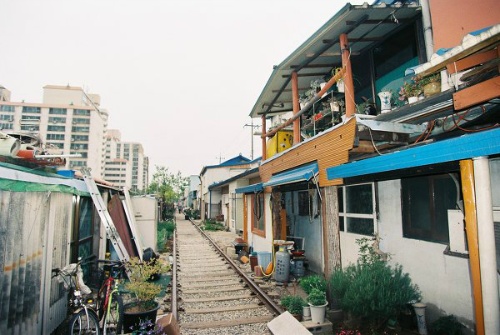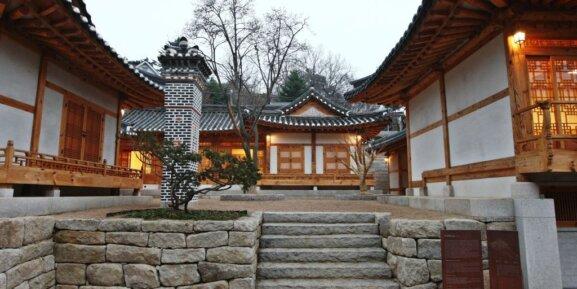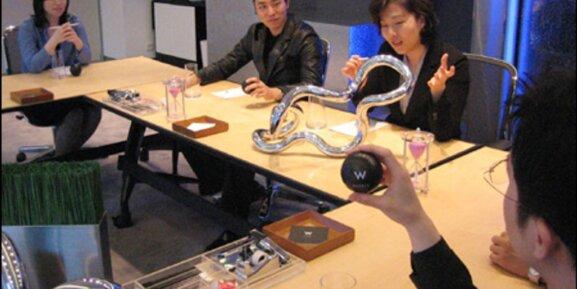A Train Runs Through It – The Railroad Neighborhood of Gyeongamdong
Passing through the sleepy city of Gunsan in North Jeolla Province, I catch sight of wide fields, smoking factories, and the blue ocean (all sources and major pillars of the city’s economy) in the distance. As a port city, the city’s beaches, surrounding islands, and hwoe (freshly sliced, raw fish) are particularly well known among Koreans but what I’m searching for is completely different- I’m searching for tracks and, specifically, the train tracks of Gyeongamdong.
Gyeongamdong is found within Gunsan city and, on first glance, resembles any other older neighborhood in Korea until you notice the pair of train tracks that cuts straight through the middle of the village. For decades, trains from the Paper Korea factory- a factory that made paper used for print news- would cross through Gyeongamdong on these tracks carrying loads of supplies and finished products. Every morning the train, with some 5 to 10 cars linked together, would slow as it approached the residential neighborhood. Station workers would scramble out, blowing their whistles and alerting the residents to stay inside as the train passed through. Parents would follow by scrambling to bring their kids, pets, and household goods inside as the trains, belching steam and booming its horn, would chug by the rows of homes along the narrow path.
While living in such a dramatic scene is unfathomable for many today, it was a part of daily life for Gyeongamdong’s residents for over half a century from 1944, when the train tracks were first completed, until 2008 when the last train passed and railway operations on the line ceased. Though the trains are now a part of history, the humble neighborhood and its way of life remains today as the area grows in popularity each year. Visitors can now walk along the 2.5km railway tracks, passing by the old homes that have sat here for decades.
Upon arrival, I’m immediately amazed at how close the homes are in proximity to the train tracks. For many of the homes, their front doors and windows are but a meter from the train tracks making it entirely possible for a resident to have simply extended his or her arms to touch a passing train. And though I imagine the hissing steam and blaring horns from the trains of the past must have been thunderous for the residents (to say the least) I notice the neighborhood is remarkably tranquil and dormant. Laundry sways in the breeze on lines above the tracks, peppers lay drying on spread out sheets, and a cat even darts out from behind a cluster of giant hanggari pots filled with various jang (fermented sauces).
Some of the homes show signs of recent renovations but most reflect the age and wear of the neighborhood’s long history. I spot an occasional dilapidated and abandoned house nestled in between homes with bikes, slippers, tools at the doorstep- signs that those homes remain occupied. Walking deeper into the neighborhood, time seems to move backward as I try and envision how life was like for the inhabitants in decades past. Images fill my mind of startled babies inside their homes, stirring from their morning slumber at the train’s boisterous noises and of curious children peeking out from their room windows and marveling at the passing hulking trains.
Now, however, the trains are long gone, replaced instead on the tracks by couples armed with selfie sticks and wearing couple outfits, no less. It’s a reflection of the surge in popularity Gyeongamdong has seen in recent years, especially after serving as the setting in the movie A Man In Love (남자가 사랑할 때) and the coming-of-age animation Green Days (소중한 날의 꿈). Since word of the unique neighborhood spread and attracted crowds, its residents have received entrepreneur inspirations and begun selling coffee, drinks, and snacks such as hoddeok from their homes.

Though the snacks and refreshments are a welcome treat from the stroll, I can’t help but feel they take away from the intimacy and history of the place. But luckily the crowds and shops dwindle as I walk further along the tracks and deeper into the neighborhood allowing me to get lost in Gyeongamdong’s charms once more. Some of the homes have their windows open making it almost impossible to not peek in. Even when I come across the occasional resident, they seem unfazed by my presence or the obvious other visitors with cameras in hand. For the residents, what was once the expected daily coming and going of hulking, steaming machines have been replaced now with chattering, clamorous tourists- a nuisance perhaps for some residents but just another day for most. I’m reminded of my initial years in Korea when I was dumbfounded at how unfazed the locals were to what seemed like everyday scenes of borderline chaos and disruption. Gyeongamdong, I note, is only further testament of the sturdy resilience of Koreans to the unpredictable disruptions that come and go in life.
As the sun sets I make the return walk back along the same well-traveled tracks for the trains that were once such a major component of life for Gyeongamdong’s residents. The blitz of Seoul life seems like such a foreign land in contrast to the leisurely pace of life here and I feel a sense of weariness at the thought of what new unexpected surprises (welcome or not) will await me back in the capital. But if anything, this short stop to leisurely Gyeongamdong has reminded me that there will always be some factors in life that are well beyond my control. So what, if the world lays down a pair of railroad tracks straight through life. Why worry when unexpected circumstances pummels through my way of life? As I’ve learned from the residents here, it’s far better to adapt around, and move on from, life’s obstacles than remain fretting.




